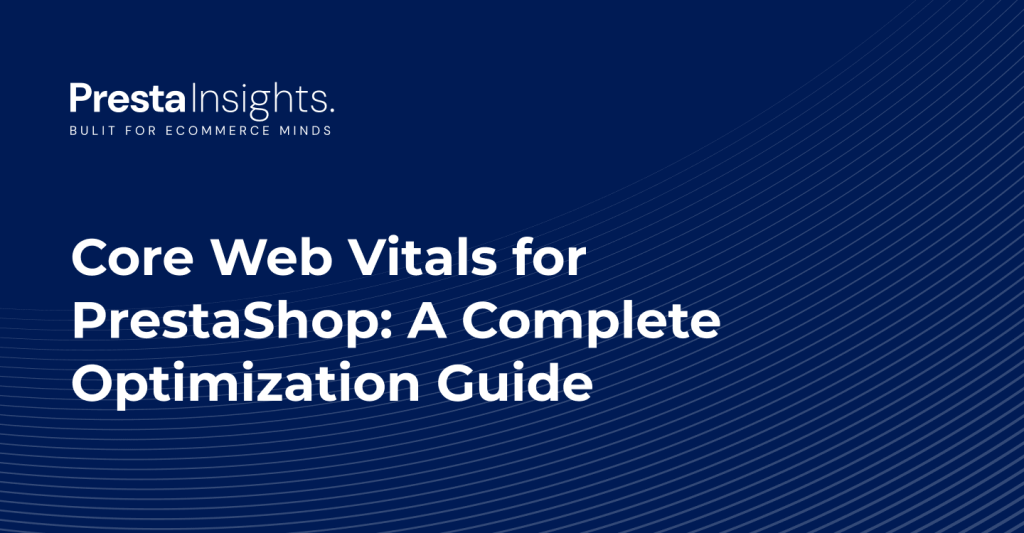Introduction
Website speed and performance have always played a crucial role in eCommerce success. But now, with Google officially using Core Web Vitals as a ranking factor, it’s more important than ever to make sure your PrestaShop store is fast, responsive, and user-friendly.
In this guide, we’ll walk you through everything you need to know about Core Web Vitals, how they affect your PrestaShop store, and practical steps you can take to optimize each metric for better SEO and user experience.
What Are Core Web Vitals?
Core Web Vitals are a set of performance metrics defined by Google to assess the user experience of a webpage. These metrics focus on three key aspects:
1. Largest Contentful Paint (LCP)
- What it measures: Loading performance.
- Good score: Less than 2.5 seconds.
2. First Input Delay (FID)
- What it measures: Interactivity.
- Good score: Less than 100 milliseconds.
3. Cumulative Layout Shift (CLS)
- What it measures: Visual stability.
- Good score: Less than 0.1.
Why Core Web Vitals Matter for PrestaShop Stores
- 🔍 SEO Rankings: Core Web Vitals are now part of Google’s Page Experience signals.
- 🛒 Conversion Rates: Faster, stable sites reduce cart abandonment.
- 📱 Mobile Optimization: With more users shopping via mobile, performance is critical.
- 💡 User Experience: Great UX leads to higher engagement and repeat purchases.
Measuring Core Web Vitals on PrestaShop
You can measure Core Web Vitals using tools such as:
- Google PageSpeed Insights
- Lighthouse (in Chrome DevTools)
- Web Vitals Chrome Extension
- Google Search Console (Experience Report)
How to Optimize Core Web Vitals in PrestaShop
1. Optimize Largest Contentful Paint (LCP)
LCP is often caused by slow server response, render-blocking scripts, or large images.
Tips to improve LCP:
- Use Fast Hosting: Choose a high-performance hosting provider like Cloudways or SiteGround.
- Optimize Images: Use WebP format, lazy-load images, and compress them with tools like TinyPNG.
- Remove Render-Blocking Resources: Defer non-critical JavaScript and CSS.
- Enable Full Page Caching: Use modules like Page Cache Ultimate or built-in caching.
2. Reduce First Input Delay (FID)
FID relates to the time between a user’s first interaction and when the browser responds.
Tips to improve FID:
- Minimize JavaScript Execution: Break long tasks, use asynchronous loading.
- Use PrestaShop Modules Wisely: Remove unused modules that inject unnecessary JS.
- Clean Up Third-Party Scripts: Review and minimize marketing tags, social widgets, etc.
3. Minimize Cumulative Layout Shift (CLS)
CLS happens when elements shift unexpectedly as a page loads.
Tips to improve CLS:
- Set Size Attributes on Images & Videos: Always define width and height in HTML/CSS.
- Avoid Injecting Content Above Fold: Don’t add banners or ads that push content down during load.
- Stabilize Fonts & Icons: Use
font-display: swapin your CSS.
PrestaShop Modules to Improve Core Web Vitals
Here are some trusted PrestaShop modules that help boost your site’s performance:
Page Cache Ultimate
Speeds up your store by caching entire pages and reducing load times.
Image Optimizer
Automatically compresses and converts your images to WebP.
Lazy Load for Images and Videos
Improves loading speed and reduces LCP.
Google PageSpeed Optimization Tool
Helps you improve PageSpeed Insights score directly from your admin panel.
Other Best Practices for Core Web Vitals Optimization
Use a Lightweight Theme
Heavy themes can slow down your store. Opt for lightweight, responsive themes optimized for performance.
Implement a CDN
A Content Delivery Network (CDN) like Cloudflare or BunnyCDN delivers your assets faster across the globe.
Avoid Module Bloat
Too many modules = more scripts = slower performance. Stick to essential ones.
Enable GZIP Compression & Browser Caching
Reduce file sizes and speed up load times through server-side settings.
Future-Proofing Your Store with Core Web Vitals
Core Web Vitals will continue to evolve. Staying up-to-date with Google’s latest metrics and web performance trends will ensure your store remains competitive.
Stay Informed
Subscribe to the Google Web.dev blog and PrestaShop community updates.
Regularly Monitor Your Site
Use tools like Search Console and PageSpeed Insights to track performance over time.
Conclusion
Optimizing Core Web Vitals in your PrestaShop store is no longer optional — it’s essential for better SEO, user satisfaction, and higher conversions.
Whether you’re a developer, store owner, or marketer, prioritizing speed and stability can give your business a serious edge in 2025 and beyond.
FAQs
Q1: What is the ideal LCP score for PrestaShop?
A: Less than 2.5 seconds is considered optimal by Google.
Q2: Do PrestaShop themes affect Core Web Vitals?
A: Yes, heavy or poorly coded themes can negatively impact loading and layout stability.
Q3: How often should I check Core Web Vitals?
A: Monthly monitoring is recommended, especially after adding new modules or updates.
Q4: Can modules alone improve performance?
A: Modules help, but a combination of good hosting, coding, and optimization practices works best.
Q5: Is it worth switching to a faster hosting provider?
A: Absolutely. Hosting plays a huge role in performance and SEO rankings.



